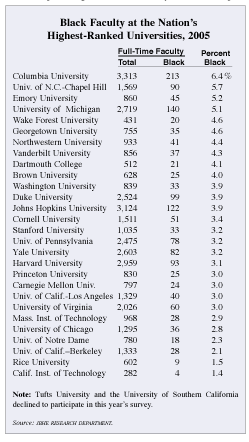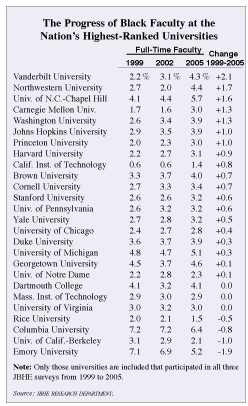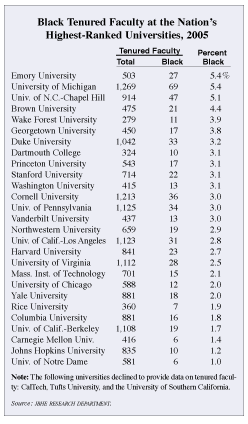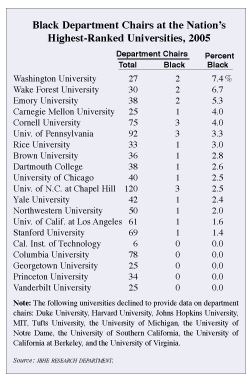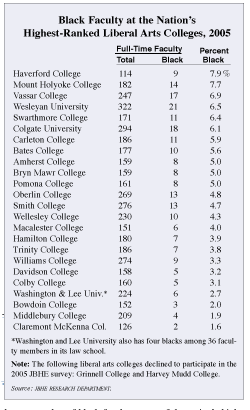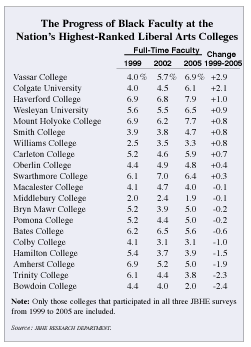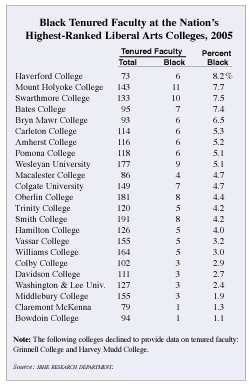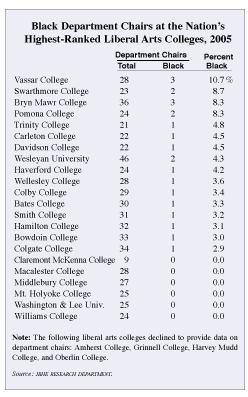| Black Faculty at the Nation's Highest-Ranked Colleges and Universities In all but a few cases, the nation's highest-ranked colleges have made only slight progress in increasing the percentage of blacks on their faculties. At the current rate of improvement, it will be a century or more before the black percentages of the faculties of these institutions mirror the black percentage of the American work force.Nationwide, just over 5 percent of all full-time faculty members at colleges and universities in the United States are black. This percentage has increased slightly over the past decade. But the percentage of black faculty at almost all the nation's high-ranking universities is significantly below the national average. JBHE recently surveyed the nation's 30 highest-ranked universities to determine the number and percentage of blacks on their faculties. We received responses from 28 high-ranking universities. Tufts University and the University of Southern California declined to provide statistics to the JBHE research department.
This Year's Results Of the 28 high-ranking universities that responded to our survey this year, blacks made up more than 5 percent of the total full-time faculty at only four institutions. Once again, as was the case in our previous survey in 2002, Columbia University has the highest percentage of black faculty at 6.4 percent. But it must be noted that after our 2002 survey was published, it was later reported that a large majority of Columbia's black faculty members were in its graduate and professional schools. Columbia professor Manning Marable told JBHE that of the 400 professors with tenure at the Columbia College of Arts and Sciences, only five were black. Professor Marable added that the number of black faculty at the undergraduate college had not increased in the past decade. We note that this summer Columbia has pledged $15 million for an effort to increase the number of women and minorities on its faculty The 90 black faculty members at the University of North Carolina made up 5.7 percent of the full-time faculty, the second highest level in our survey. At Emory University in Atlanta, blacks are 5.2 percent of the total faculty. At the University of Michigan, there are 140 black full-time faculty, the most of any university in our survey. They make up 5.1 percent of the full-time faculty on the Ann Arbor campus. At 24 of the 28 universities that responded to our survey, the black percentage of the total faculty was below 5 percent. Only four of the 282 faculty members at CalTech are black. Thus, blacks are 1.4 percent of the faculty at this prestigious institution. At Rice University in Houston, blacks are only 1.5 percent of the faculty. At MIT, the University of Chicago, and the University of Notre Dame, blacks are less than 3 percent of the total faculty. It is difficult to determine why there are such wide institutional disparities in the numbers of black faculty. Certainly, the very small number of blacks pursuing Ph.D.s in engineering and the natural sciences is mirrored in the low percentages of black faculty at science-oriented institutions such as Carnegie Mellon University and the California Institute of Technology. As expected, institutions with high percentages of black faculty have characteristically shown a commitment to hire African Americans to junior faculty positions. Emory University in Atlanta has a strong record in hiring black junior faculty. But many of the Ivy League colleges tend to do lateral hirings of established African-American academics from other institutions. Overall, it appears that results largely depend on whether the faculties that control hiring at particular universities have a strong commitment to developing a racially diverse teaching corps. Much depends, too, on who has the power to hire faculty. At most prestigious universities the authority to engage faculty tends to be lodged in the departments concerned. University presidents and deans have little or no say in the hiring process. At best they can cajole members of the various departments involved. Faculty departments traditionally explain their poor performance on the ground that there are no qualified African Americans in the Ph.D. pipeline. But the fact that so many of our great universities such as Duke, Georgetown, Emory, and Chapel Hill have been highly successful in recruiting African-American faculty tends to show that the "no blacks in the Ph.D. pipeline" thesis is at worst a red herring and at best a weak explanation for poor results.
Snail-Like Progress in Adding Black Faculty For the 26 high-ranking universities for which we have faculty data in both 1999 and 2005, we are encouraged to report that only four universities experienced a drop in the percentage of blacks on their faculties. The most impressive progress was at Vanderbilt University where the black percentage of the total faculty increased from 2.2 percent in 1999 to 4.3 percent this year. At Northwestern University, the percentage of blacks on the faculty dropped from 2.7 percent in 1999 to 2.0 percent in 2002. Since that time substantial progress has been made. The university administration established a $1 million fund for the explicit purpose of recruiting black faculty members. Dwight McBride was hired from the University of Illinois at Chicago to spearhead the effort. In the fall of 2002, 10 new black faculty members were hired. Another major coup came later with the recruitment of historian Darlene Clark Hine from Michigan State University. Now blacks are 4.4 percent of the total faculty, more than double the level of just three years ago. Carnegie Mellon University, Washington University, Johns Hopkins University, and Princeton University also posted at least a one percentage point gain in their level of black faculty during the 1999 to 2005 period. Twelve leading universities posted slight gains of less than one percentage point. But at this snail's rate of progress, it will be more than a century before the black percentage of the faculty at these institutions even approaches the level of blacks in the work force. And at many institutions the progress is so slow that it will be a century or more before the black percentage of the total faculty nears the black percentage of all those who earn doctoral degrees in this country. At three universities there was no progress in the level of black faculty in the 1999 to 2005 period. At two of these three schools, the level of black faculty dropped from the 2002 to 2005 period. At Rice University, the University of California at Berkeley, Columbia University, and Emory University, the percentage of blacks on the faculty has dropped since 1999. At Emory the drop was substantial, from 7.1 percent of all faculty in 1999 to 5.2 percent this year. But we remind the reader that Emory still ranks second in our survey for the percentage of black faculty this year. At Berkeley, clearly the prohibition against affirmative action in faculty hiring has had a negative impact on black faculty levels since 1999. During the period the number of full-time black faculty members at the university has dropped from 45 to 28.
The Tenure Breakdown Ranking the major universities according to numbers and percentages of tenured faculty produces results that are somewhat different from faculty totals. According to our current survey, the University of Michigan, with 69, has the most tenured black faculty. Next is the University of North Carolina at Chapel Hill with 47 black tenured faculty. Blacks make up 5.4 percent of all tenured faculty at Emory University and at the University of Michigan. This is the highest percentage rate among the institutions surveyed. At the University of North Carolina at Chapel Hill, blacks are 5.1 percent of the tenured faculty. At Brown, 4.4 percent of the tenured faculty are blacks. At all other high-ranking universities in our survey, blacks make up less than 4 percent of the total tenured faculty. Blacks make up less than 2 percent of the tenured faculty at Rice University, Columbia University, the University of California at Berkeley, Carnegie Mellon University, Johns Hopkins University, and the University of Notre Dame. At 1.8 percent, Columbia has the lowest percentage of black tenured faculty among the Ivy League schools. Brown University has the highest percentage of blacks among its tenured faculty at 4.4 percent. At Dartmouth and Princeton, 3.1 percent of the tenured faculty are black. This is the second highest level in the Ivy League.
Blacks Serving as Department Heads For the first time, our analysis of the status of black faculty at the nation's highest-ranked universities includes a survey of the number and percentage of department heads who are black. Chairs of academic departments play a major role in faculty recruitment efforts. Blacks in these positions can have a significant impact in attracting other blacks to a particular university. Twenty of the nation's 30 highest-ranked universities supplied data on the racial makeup of their department chairs. The University of North Carolina at Chapel Hill, Cornell University, and the University of Pennsylvania each have three black department chairs, the most in our survey. Blacks are 7.4 percent of all department chairs at Washington University in St. Louis. This is the highest percentage of black department chairs among the high-ranking universities that responded to our survey. There are no black department chairs at CalTech, Georgetown, Princeton, Columbia, or Vanderbilt. At some of the universities with only one black department chair, that person heads up the black studies department. Black Faculty at the Nation's
Now we turn to the nation's prestigious liberal arts colleges. These colleges tend to be small. In many cases they have about one tenth or less the number of faculty in place than do the large research universities. In addition, many of these leading liberal arts colleges are located in remote rural areas far from any black population centers. Therefore, one would expect that many of these colleges would have an extremely difficult time recruiting and holding black faculty.
But this is not the case. Our survey shows 11 of the nation's 24 leading liberal arts colleges that responded to our survey have a faculty that is at least 5 percent black. Recall that only three of the nation's highest-ranked universities in our survey have a faculty that is at least 5 percent black. There are 21 full-time black faculty members at Wesleyan University. This is the largest number of black faculty members at the elite liberal arts colleges. Colgate University has 18 full-time black faculty. Vassar College in Poughkeepsie, New York, has 17 black faculty members. Mount Holyoke College ranks fourth among the prestigious liberal arts institutions with 14 black faculty members. Claremont McKenna College in California has only two blacks on its faculty. This is the lowest number of black faculty at any of the nation's highest-ranked liberal arts colleges. There are only three black faculty members at Bowdoin College in Maine and only four blacks at Middlebury College in Vermont. On a percentage basis, blacks make up nearly 8 percent of the total faculty at Haverford College outside of Philadelphia. This is the highest percentage of black faculty among the high-ranking liberal arts colleges. Mount Holyoke ranks second with a black faculty that is 7.7 percent of its total. The strong performance of Mount Holyoke, located in an essentially rural area of New England, is a signal achievement. Both Middlebury College and Claremont McKenna College have faculties that are less than 2 percent black. Blacks are less than 3 percent of the total faculty at Washington and Lee University and at Bowdoin College. It should be noted that there are four blacks teaching at the law school at Washington and Lee University. They make up 11 percent of the total law school faculty. Progress of Black Faculty at the
While the liberal arts colleges have achieved a superior record in black faculty hiring compared to the large research universities, their record in overall progress in increasing the number of blacks on their faculties in recent years is a mixed bag. For the 20 high-ranking liberal arts colleges for which we have data for the 1999 to 2005 period, 10 have increased their percentage of black faculty and 10 have seen a reduction. Vassar College has shown the biggest improvement. In 1999 blacks were 4 percent of the Vassar faculty. Now blacks are nearly 7 percent of the total faculty at the college. At Colgate University, the percentage of the total faculty who are black has increased from 4.0 percent in 1999 to 6.1 percent this year. Haverford, Mount Holyoke, Wesleyan, Williams, Smith and Carleton have also shown significant increases in their level of black faculty during the period. At Bowdoin College there were five black faculty members in 1999. Today there are three. As a result, the black percentage of the total faculty at Bowdoin has been reduced from 4.4 percent to 2 percent. At Trinity College in Hartford, Con-necticut, the number of black faculty members dropped from 11 to 7 in the 1999 to 2005 period. Therefore, the black percentage of the total faculty at Trinity dropped from 6.1 percent in 1999 to 3.8 percent today. Explaining the Superior Performance of
Our surveys of black faculty at the nation's leading research universities and liberal arts colleges present an intriguing question: Why have the liberal arts colleges been more successful in attracting black faculty than the nation's large research universities? There are several possible explanations: • First, the large research universities are likely to have extensive programs in the sciences and engineering, fields that traditionally have had few black academics. While many liberal arts colleges have excellent science programs, science faculty are likely to make up a much smaller percentage of the total faculty than is the case at the larger research universities. • The most popular majors at liberal arts colleges, such as psychology, English literature, political science, and sociology, are fields in which there are significant numbers of black scholars. • Despite their size, most of these small liberal arts colleges have black studies programs. Black studies is in many cases an interdisciplinary program that fits in nicely with a general liberal arts program. These small colleges undoubtedly seek out black academics to teach courses in black studies. • Many large research institutions have deeply entrenched and virtually all white academic departments that are distinctly unsympathetic to administration pressures to engage black academics. Indeed, some students of academic hierarchies believe that pretenses of racial open-mindedness often expressed in solemn commitments to greater diversity are a form of behavior more common at our great universities than at the small liberal arts schools.
• Small liberal arts colleges often provide an environment in which black scholars are able to concentrate on teaching in a small class setting. This affords them an opportunity to comfortably mentor young African-American students. • The isolation of many campuses of liberal arts colleges often shields black academics from some of the burdens of being black in a white man's world. The campus of a liberal arts college tends to present a secure and generally racially tolerant atmosphere in which recruiting decisions are made closer to the top of the organization. Tenured Black Faculty at
In terms of tenured black faculty, once again the liberal arts colleges outperform the highly ranked universities. According to the JBHE survey, nine high-ranking liberal arts colleges have a tenured faculty that is 5 percent or more black. Recall that only three of the nation's highest-ranked research universities had tenured faculties that were at least 5 percent black. There are 11 black faculty members holding tenure at Mount Holyoke College, the highest number in our survey among the prestigious liberal arts colleges. There are 10 black tenured faculty at Swarthmore College and eight each at Smith and Oberlin. At Swarthmore, 10 of the 11 black faculty members hold tenure. There is only one black holding tenure at both Claremont McKenna College and Bowdoin College. In percentage terms, Haverford leads the small highly ranked liberal arts colleges. Six of the 73 tenured faculty at Haverford, or 8.2 percent, are black. Six of the nine black faculty members at Haverford hold tenure. At Bates, Mount Holyoke, and Swarthmore, blacks are at least 7 percent of the tenured faculty. At Middlebury College, Claremont McKenna College, and Bowdoin College, blacks are less than 2 percent of the tenured faculty. Only five of the 17 black faculty members at Vassar College hold tenure.
Black Department Heads at Liberal Arts Colleges There are three black department chairs at both Vassar College and Bryn Mawr College. Nearly 11 percent of all department chairs at Vassar and more than 8 percent of the department chairs at Mount Holyoke are black. There are two African-American department chairs each at Pomona College, Swarthmore, and Wesleyan University. No other highly ranked liberal arts college has more than one black department chair. There are no black department chairs at Claremont McKenna College, Macalester College, Middlebury College, Mount Holyoke, Washington and Lee University, or Williams College. | |




